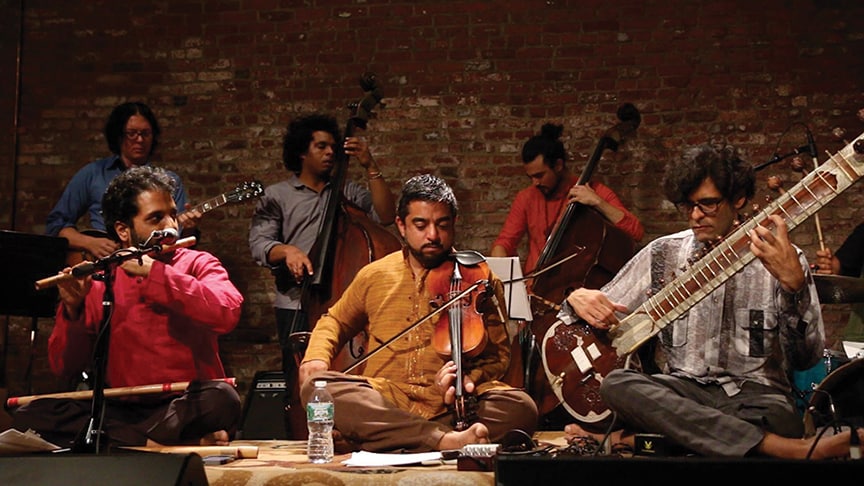From February to April, the Brooklyn-based music collective Brooklyn Raga Massive (BRM) is bringing Indian classical music fused with a wide range of contemporary and world music styles to Red Hook during a 13-week residency at Pioneer Works. Since the inception of its artist residency program in 2012, Pioneer Works, a former ironworks facility, has been fostering cross-disciplinary and cross-genre dialogue between artists and community members. In this vein, BRM’s residency brings weekly concerts, workshops, films, educational opportunities, food, and dance to Red Hook.

Photo credit to Andrew Mendelson.
Founded four years ago, BRM consists of about 12 steadfast members—Indian classical musicians, mostly born and raised in the U.S., but rooted in India. What brought them together four years ago was their interest in exploring new ways of crossing into other musical genres and representing Indian classical music in the here and now to new audiences.
“We connected on that exploration,” says Arun Ramamurthy, one of BRM’s co-founders. “Like-minded individuals just sort of come together like magnets. We realized something exciting happening and decided to grab it [and form BRM].”
One of the aims of the residency, according to Ramamurthy, is to bring Eastern and Western, ancient and contemporary worlds together and bridge the gap that often exists between these worlds. “Indian classical music can be viewed as hard to get to,” says Ramamurthy. “We want to create music and art that brings our worlds together and push forward the music in a way that we can all understand it and bring people together.”
BRM kicks off its Red Hook residency on February 3rd with a concert that brings African and Indian worlds together. Awa Sangho’s “golden voice of Mali” meets upon the electro-acoustic sounds of a duo on tabla (an Indian percussive instrument) and kora (a 21-string West African harp-like instrument). The African mbira (an African ‘thumb piano’), South Asian bansuri flute, and BRM musicians add to the canon.
Wednesday residency at Pioneer Works
The multi-genre, multi-disciplinary concert series continues every Wednesday thereafter throughout February, March and April. Each week focuses on a different theme, highlighting a different aspect of Indian classical music and its relationship to other genres and disciplines. February 10th highlights the interconnectedness of dance and music with BRM musicians accompanying a range of solo dancers rooted in Indian classical dance. February 17th bends the boundaries of Jugalbandhi, typically a duet between solo musicians, but here taking on new life. February 24th pays tribute to George Harrison and the Beatles, who, famously, helped introduce Western audiences to the traditions of Indian music through some of their own music.
Each week’s performance is preceded by a workshop or film that adds another dimension to the evening’s concert. On Thursdays, meanwhile, a six-week interactive seminar offers participants the opportunity to delve into the metaphysical system of Nada Yoga, which forms the bedrock of all Indian classical music. (Meaning ‘union through sound’, Nada Yoga is a spiritual art and science that allows one to walk the avenues of sound and music to reach the surrounding universe.) Participants will explore ways to apply these principles to their own musical, creative, or listening endeavors. Overall, the 13-week residency will allow BRM and collaborators to embark on a new composition and recording project that will result in an album that “captures the energy” of their Red Hook residency.
But Brooklyn Massive Raga—what’s in the name? Literally, raga translates as ‘that which colors the mind’, explains Ramamurthy. Musically, ragas are like scales, but different in that there are ornamentations on the notes. Ornaments combined with notes make up a raga. Or in other words: A human being consists of the physical attributes of bones and skin (notes), but can also take on different emotional qualities like sadness, happiness, and hopefulness (ornamentations). Similarly, a raga can take on different qualities. “Ragas are a musical tool for individuals to express themselves in music,” says Ramamurthy. “When artists perform in ragas their intention is to connect with each member of the audience. It’s very meditative, peaceful music. You have to experience it to know how it moves you.”
Author
Discover more from Red Hook Star-Revue
Subscribe to get the latest posts sent to your email.









